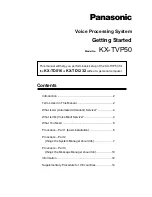
User Guide
User Guide
10-64
DNS
Domain Name System: A method to locate and translate Domain Names into Internet Protocol
(IP) addresses, where a Domain Name is a simple and meaningful name for an Internet address.
FTP
File Transfer Protocol: A standardized internet protocol which is the simplest way to transfer
files from one computer to another over the internet. FTP uses the Internet's TCP/IP protocols to
function.
Gateway
A point on the network, which is an entrance to another network. For example, a router is
a gateway that connects a LAN to a WAN.
Host
In context of Internet Protocol, a host computer is one that has full two way access to other
computers on the Internet.
IP
Internet Protocol: The method by which information is sent from one computer to another
through the Internet. Each of these host computers have a unique IP address which distinguishes it
from all the other computers on the internet. Each packet of dVoIP ATA sent includes the sender's
IP address and the receiver’s IP address.
LAN
Local Area Network: A group of computers, typically covering a small geographic area, that
share devices such as printers, hard disk drives, scanners, and optical drives. Computers in a LAN
typically share an internet connection through some sort of router that connects the computers to a
WAN.
MAC Address
Media Access Control Address: A unique hardware number on a computer or device
that identifies it and relates it to the IP address of that device.
Ping
Packet Internet Groper: A utility used to determine whether a particular device is online or
connected to a network by sending test packets and waiting for a response.
Proxy
A device that closes a straight connection from an outside network (WAN) to an inside
network (LAN). All transmissions must go through the proxy to get into or out of the LAN. This
makes the internal addresses of the devices in the LAN private.
Subnet Mask
Short for SUBNETwork Mask, subnet mask is a technique used by the IP protocol to
filter messages into a particular network segment, called a subnet. The subnet mask consists of a
binary pattern that is stored in the client computer, server, or router. This pattern is compared with
the incoming IP address to determine whether to accept or reject the
packet.
TCP
Transfer Control Protocol: Works together with Internet Protocol for sending dVoIP ATA
between computers over the Internet. TCP keeps track of the packets, making sure that they are
routed efficiently.
TFTP
Trivial File Transfer Protocol: A simple version of FTP protocol that has no password
authentication or directory structure capability.






































